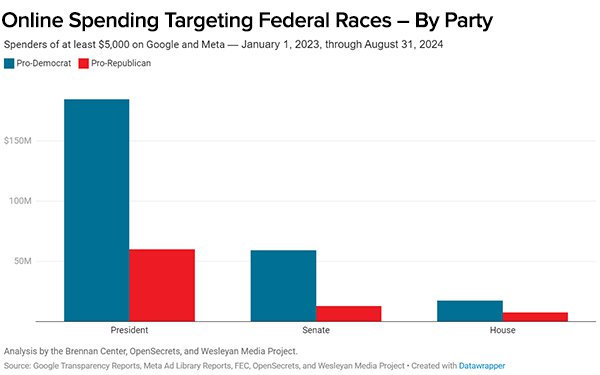
Google has announced temporary restrictions on political
advertising related to U.S. elections, effective after all polls close on Election Day.
"We will pause ads relating to US elections from serving in the US after the last polls close on
election day, November 5th, 2024," the company said in a post.
Google's pause affects all ads related to U.S. elections and their processes or outcomes.
This includes election
ads and broader election-related content. Exempt are public information campaign ads run by state or federal election administration bodies.
The blog
post states U.S. election ads are those that feature "a current officeholder or candidate for an elected federal office. A current
officeholder or candidate for a state-level elected office, such as Governor, Secretary of State, or member of a state legislature. A current officeholder or candidate for a U.S. territory-level
elected office, such as Governor or a member of a territory legislature. A federal, state, or territory-level political party; or a state or territory-level ballot measure, initiative, or proposition
that has qualified for the ballot in its state or territory."
advertisement
advertisement
Advertisers that spent at least $5,000 in ads through the end of August 2024 on Google and Meta bought $619 million in political
ads, with at least $248 million focused on the presidential race, according to joint analysis by the Brennan Center, OpenSecrets, and the Wesleyan Media Project.
The report combines publicly
available data from Google and Meta to shed light on the scope of online spending this election cycle on the two largest online platforms.
Political advertisers in the United States spent more
than $619 million on Google and Meta between the beginning of 2023 and the end of August 2024, according to recent data. Since the data was collected, the pause in ads was announced by Google.
Spend in favor of Democrats was more than three times the amount of spending for Republicans on Meta and Google.
Some Republican-aligned spending may have migrated to other platforms not
included in this analysis, in part due to lack of public data, but nearly half the total -- $281 million -- came from spenders that may hide some or all of their donors.
The data shows a
complete list of spend for both parties.
The origin for some of the donations
for money spent on Google and Meta platforms was disclosed in the report, but spenders can use “dark money” nonprofit organizations to keep their donors hidden. There is even less
transparency online than in other media due to a lack of regulation.
Of the $619 million in spending in the sample, 45% came from spenders that may conceal some or all of their donors.
Nonprofits that typically don’t disclose any of their donors spent $106 million, while $65 million is “gray money” from political committees that can partially conceal their
donors.
An example of “gray money” is Americans for Prosperity Action, one of the top online spenders with more than $7 million in ad buys, according to the report.
As a super PAC, it is required to report its donors, but one of its biggest donors is an affiliated dark money group that contributed $25 million from unknown sources.
The report states
that another $109 million came from groups whose form of organization is unknown.
The remaining spending in the sample -- $339 million -- was spent by campaigns, parties, and other groups that
are required by state or federal law to fully disclose their donors.